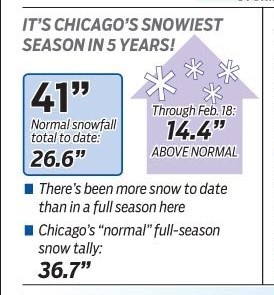OK, raise your hand if you are one of us that feels like it is never going to stop snowing this winter. Mother Nature started us off with a bang in November with some light accumulations leading up to the big Thanksgiving blast that left seven to eleven inches on the ground in the northwest suburbs. Then she seemed to take a nap in December but woke up crabby and ready to wage weather war again in January; and she has been relentless ever since.

Snow accumulation totals for this winter are already more than a foot over our average for an entire winter, and we still have a month left before we can even start talking about spring. Along with all of this snow we have had more than our share of all of the other nasty weather elements Mother Nature keeps in her bag of tricks. Historic ice storms, a polar vortex that crushed century old temperature records, rain, sleet, freezing rain, hail, and yes, even graupel. In case you were wondering what graupel is, read on…

Ice storms don’t hit the Chicago area often because they require just the right combination of cold upper air, warm air above ground level and cold air right near the ground. But when they do happen, ice storms that leave less than an inch of ice on the ground can be much more disruptive than sleet, freezing rain, or snowstorms that leave similar amounts of precipitation.
But what exactly is the difference between rain, freezing rain, sleet, ice, etc. and why do we need so many terms for this winter precipitation. Whether or not precipitation remains snow or transitions to rain, freezing rain, sleet, hail, or graupel by the time it reaches the ground hinges on the temperature fluctuations the snowflakes may encounter as they travel through the layers of the atmosphere.
When the temperature between the ground and the clouds remains at or below the freezing mark (32F), precipitation will fall in the form of snow. It is possible for snow to fall when temperatures are above 32, as long as the layer of above-freezing air near the surface is rather shallow, not allowing the snowflakes to melt.
Sleet and freezing rain occur by a similar process but are different forms of precipitation. Sleet occurs when snowflakes melt into a raindrop in a wedge of warm air well above the ground and then refreeze in a layer of freezing air just above the surface. This results in frozen raindrops, or small ice pellets. Freezing rain occurs when the wedge of warm air aloft is much thicker, allowing the raindrop to survive until it comes in contact with the cold ground. A coating of ice then forms on whatever the raindrops contact. Freezing rain is by far the most dangerous because it forms a solid sheet of ice, as opposed to sleet that just has small ice pellets that quickly bounce off of the surface. Interestingy, sleet can even provide a little bit of traction for drivers, as opposed to the obvious dangers of a solid sheet of ice that forms from freezing rain.
And I have not forgotten, in case you were wondering what graupel is, graupel (snow pellets) forms when snowflakes are coated with a layer of ice. Graupel is typically white and opaque. Unlike hail or sleet, graupel is soft and can fall apart easily in your hand. Graupel is also usually smaller than hail, with a diameter of around 0.08-0.2 of an inch.
The demand for ice melt applications to remedy this onslaught of frequent, diverse precipitation has been high, exacerbated by the intermittent freeze/thaw cycles we have also seen that create melted runoff that refreezes overnight. The need for more salt/chemical applications has resulted in some difficulty on the part of the suppliers keeping up with the demand of contractors. Typically, suppliers are required to supply municipalities and transportation authorities first to ensure that the road ways are kept safe, leaving a high demand from contractors to take care of private properties. Higher demand can also mean higher prices, which you may see in the future.
If your budget has been blown up by the cost of clearing snow and keeping up with these applications, you are not alone. Commercial building managers, retail mall owners, and HOAs alike share in the budget pain that this winter is creating.
However, the safety of employees, residents, visitors, etc. and the ability of vehicles to effectively navigate around your property should always be paramount when balancing the cost considerations that must be confronted in the midst of a winter like this one.
Hang on though, two weeks ago, Punxsutawney Phil emerged from his burrow around 7:30 a.m. ET and did not see his shadow, predicting an early spring for us all. A member of Phil’s Inner Circle read from the groundhog’s prediction scroll to the cheers and applause from the crowd;
“Faithful followers, there is no shadow of me and a beautiful spring it shall be.”
As the legend goes, if Phil sees his shadow, he considers it an “omen” of six more weeks of bad weather and heads back into his hole. If it’s cloudy and he doesn’t, you can put away that winter coat sooner than expected. But of course, his predictions aren’t always correct. Statistically, you’re better off trying to decide what the rest of February and March will look like by flipping a coinsince Phil’s accuracy record is only 40%. At least with a coin you will be right half of the time.
Kevin T. Block
